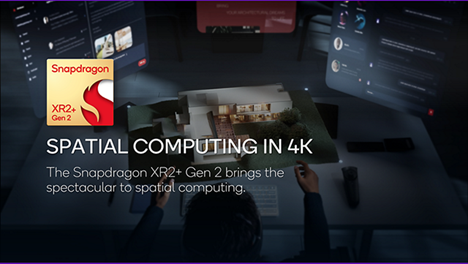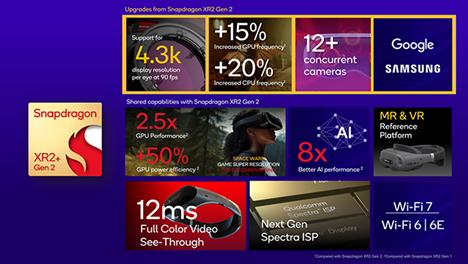Qualcomm launched Snapdragon XR2+ Gen 2 platform, with a unified chip architecture for 4.3K per-eye spatial computing at 90 frames per second, enhancing visual clarity in MR and VR. It builds on the capabilities of the Snapdragon XR2 Gen 2, offering a 15% higher GPU frequency and 20% higher CPU frequency. With support for over 12 cameras and on-device AI, it allows for seamless user tracking and navigation in both physical and digital spaces. Qualcomm also unveiled a new MR and VR reference design with Goertek that incorporates Tobii’s eye-tracking technology and supports both 3K and 4K per-eye configurations.

Ahead of CES, Qualcomm Technologies has introduced the Snapdragon XR2+ Gen 2 Platform, a unified chip architecture enabling 4.3K per-eye spatial computing at a smooth 90 frames per second, promising striking visual clarity for both work and leisure activities. Building on the capabilities of the previously announced Snapdragon XR2 Gen 2, the new ‘+’ version enhances immersive experiences in mixed reality (MR) and virtual reality (VR) with a 15% higher GPU frequency and a 20% higher CPU frequency. With support for 12 or more concurrent cameras equipped with on-device AI, the Snapdragon XR2+ Gen 2 can track users, their movements, and the surrounding environment, providing seamless navigation and experiences that blend the physical and digital realms.
In an effort to expedite the time to market for OEMs, Qualcomm has also revealed a new MR and VR reference design created in collaboration with Goertek, featuring eye-tracking technology from Tobii. This reference design accommodates both 3K per eye (Snapdragon XR2 Gen 2) and 4K per eye (Snapdragon XR2+ Gen 2) configurations.

Meanwhile, Samsung expressed support for the new XR2+. Samsung suggested they might have something under development. Shahram Izadi, vice president of AR at Google, also shared his anticipation for the ongoing collaboration with Qualcomm Technologies and Samsung in shaping the future of immersive and spatial XR. Meanwhile, Inkang Song, vice president and head of the technology strategy team at Samsung Electronics ,said, “We are excited to partner with Qualcomm Technologies and Google to bring about another revolution in the mobile industry.” He expressed enthusiasm about leveraging Samsung’s mobile expertise and joint commitment to deliver an unparalleled XR experience for Galaxy users.